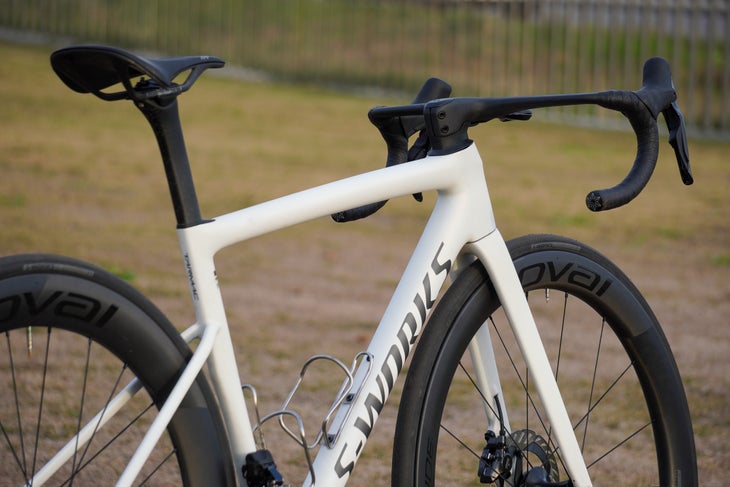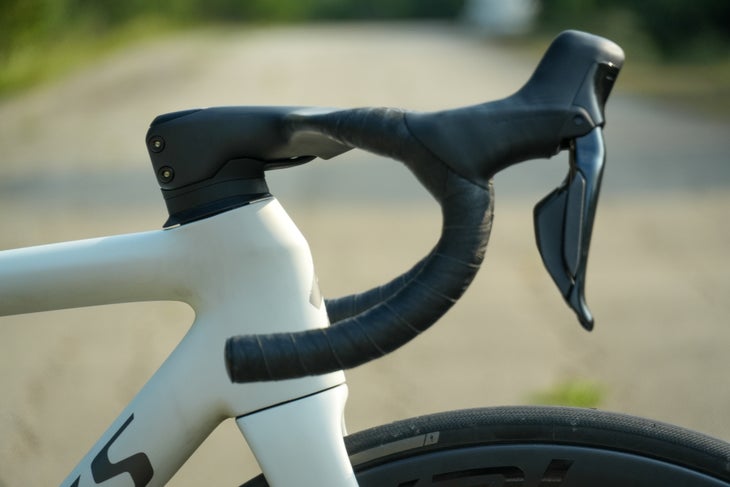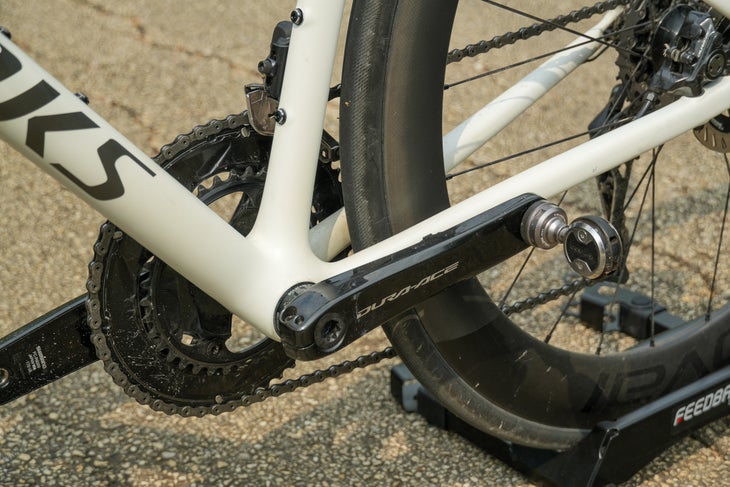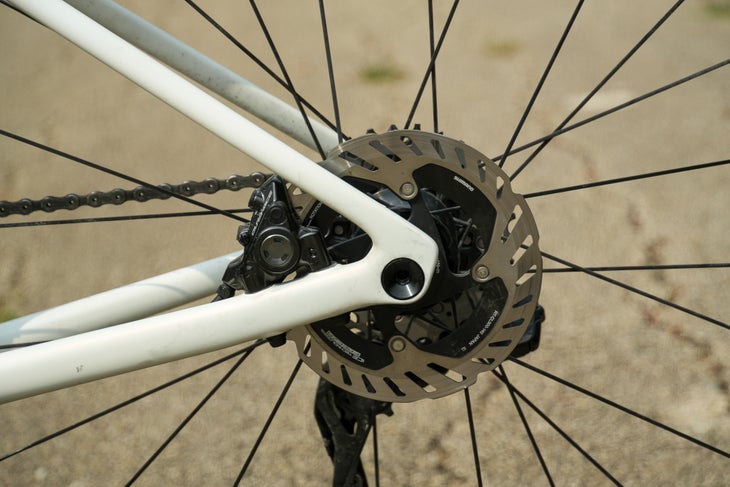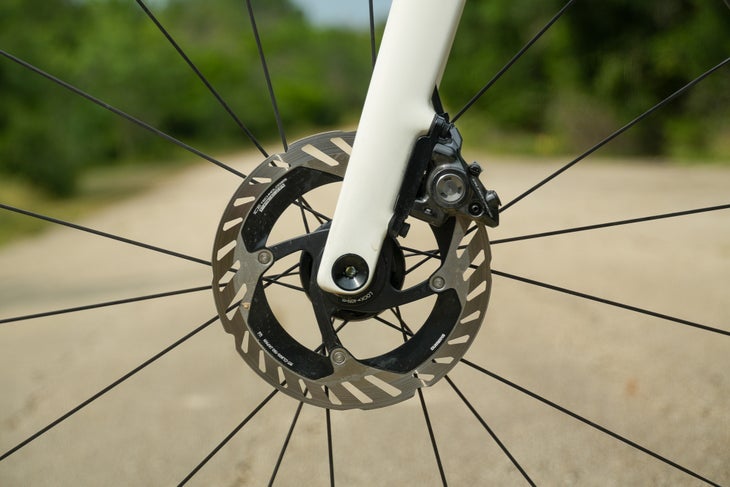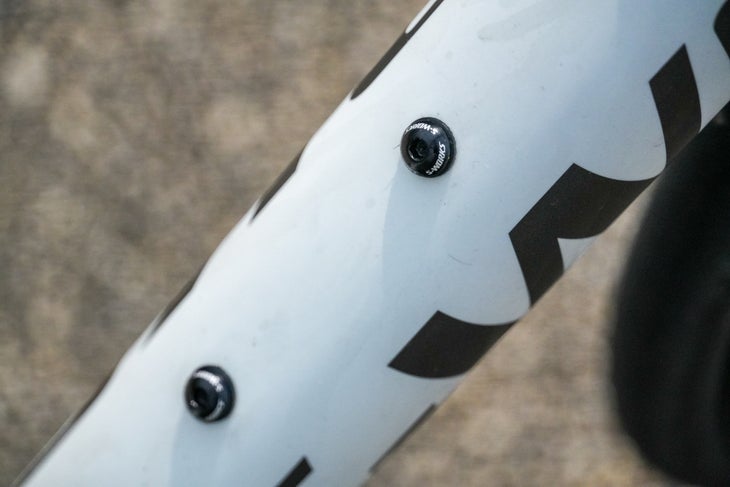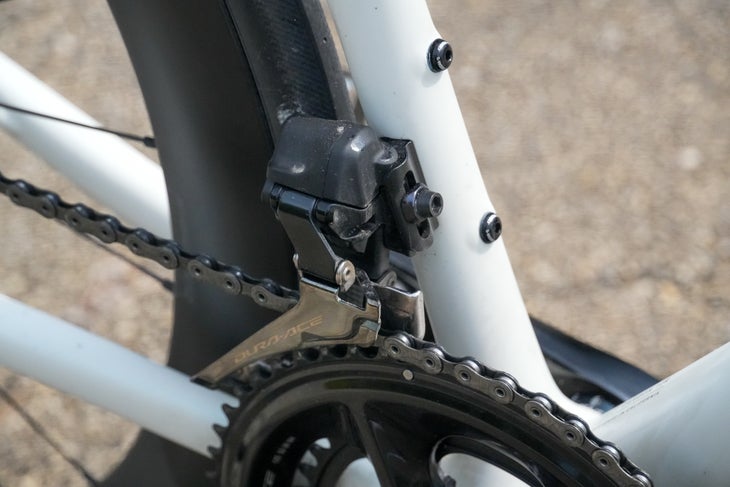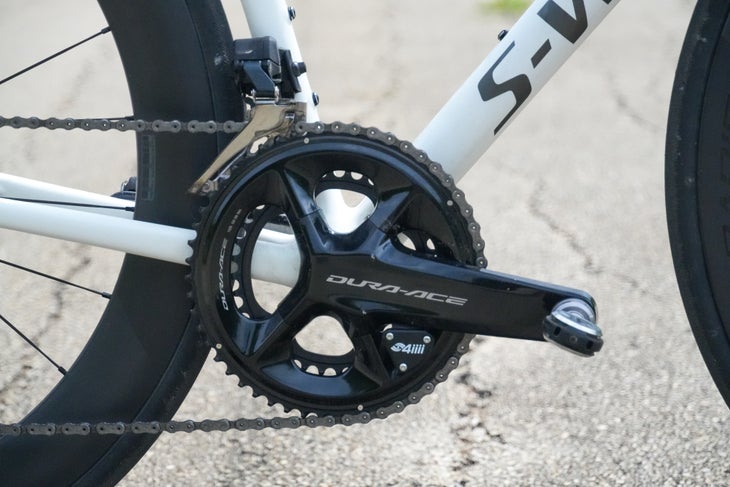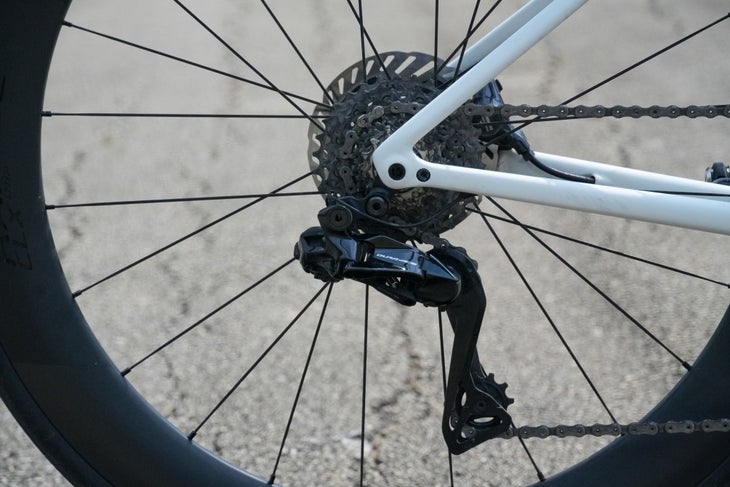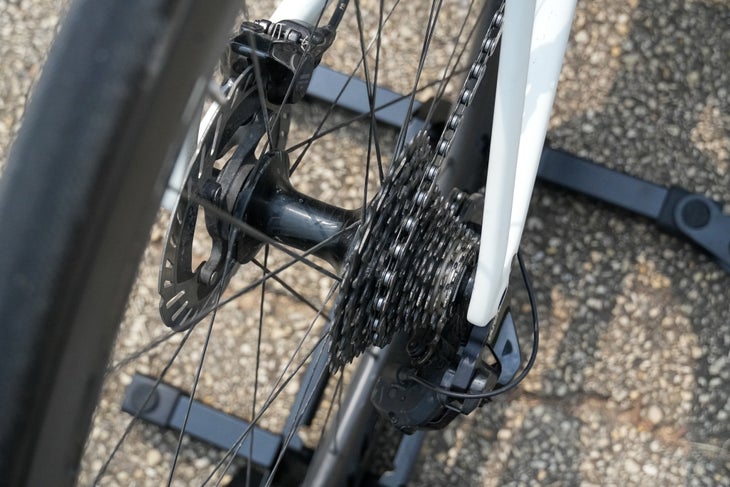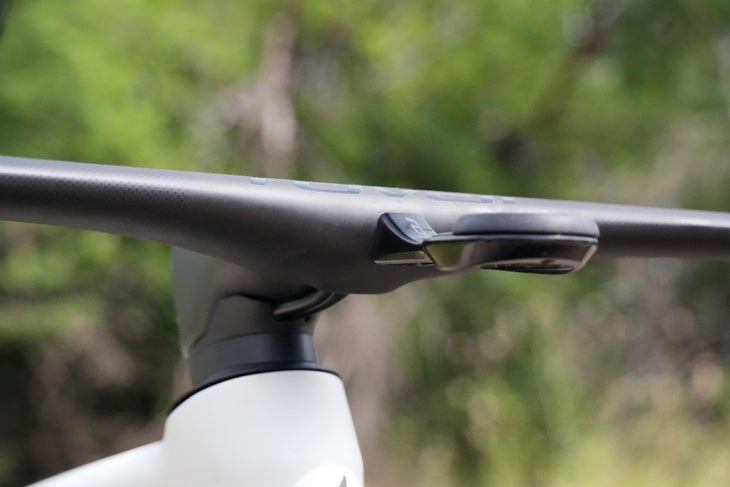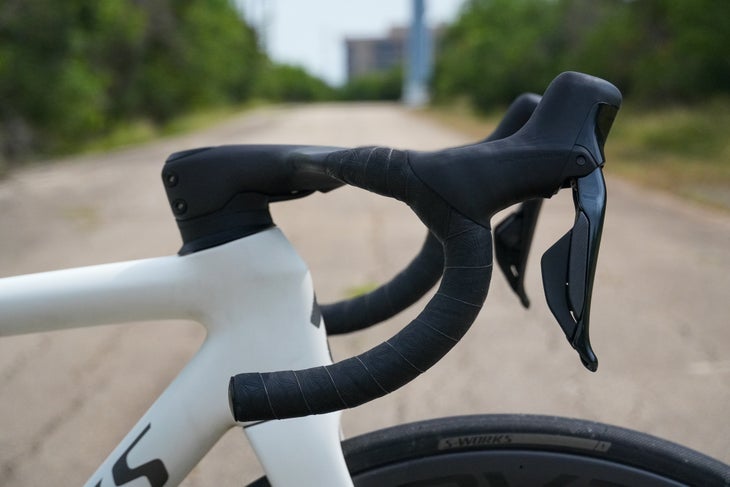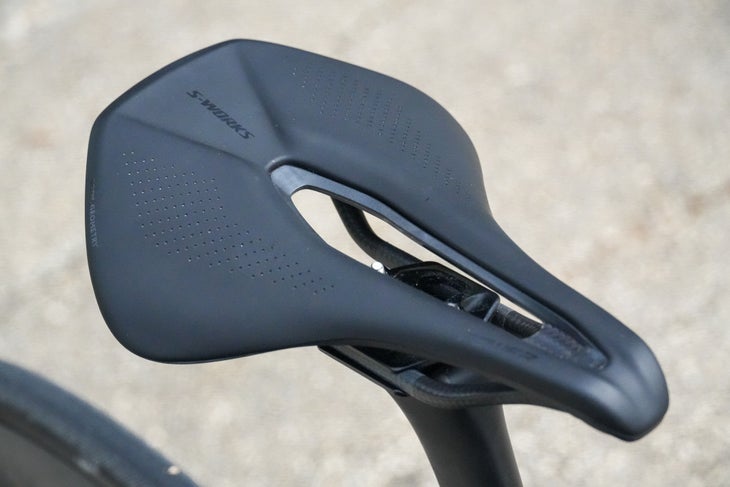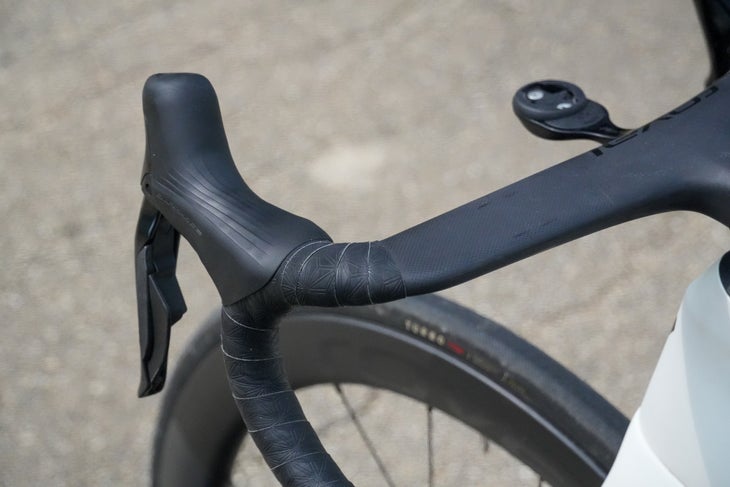The Specialized Tarmac road bike is everywhere, or at least that’s how I felt when I rode this test bike here over the last eight months. There’s a good reason for it: Specialized is one of the best-known bike brands in the world, and the Tarmac name is traditionally attached to the brand’s defacto race road bike.
With the release of the Specialized Tarmac SL8 came massive claims. The S-Works frame here was a massive 100 grams lighter than the previous generation S-Works Tarmac. The Specialized Tarmac SL8 – with its divisive Speed Sniffer nose cone – helps make the bike more aerodynamic than even the Venge aero road bike. And even more, Specialized said this new bike was massively stiffer too. Heady claims.
Of course, with all of that change–or lack thereof–comes a number of questions. Is the SL8 worth upgrading to over the Tarmac SL7? What’s it like riding the bike over 1500 miles (~2500 km)? How much does the Tarmac really weigh? Good question. We have the answers.
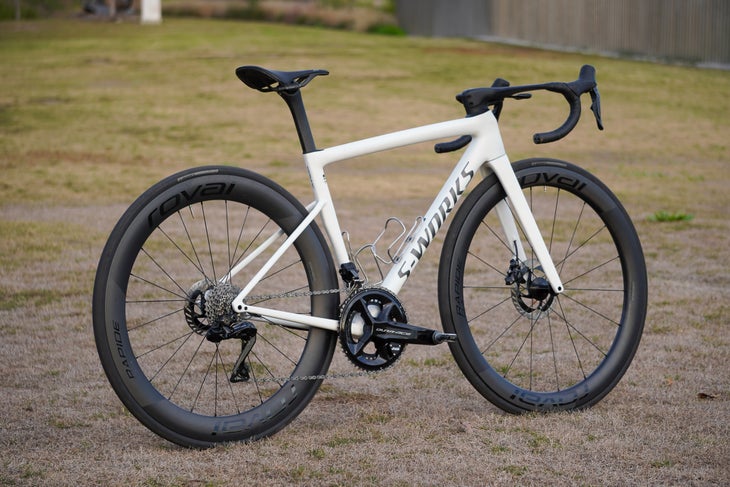
Build details
I won’t focus too much on the numbers, as you can find how much faster the SL8 is than the outgoing SL7 in my first ride review, or our interview with Specialized’s Road Product Manager, Miles Hubbard, here. But the gist is that the SL8 is both faster and lighter. Shocker, I know.
That extra speed comes from a focus on optimizing ‘leading edges,’ or the spots where the wind hits the bike first as you’re riding along. There are five points of focus with the Tarmac: the head tube, the fork, the handlebar, the seat tube, and the seat post. According to Specialized, the head tube is a considerable part of the frame’s aero improvements. So if you don’t dig the Speed Sniffer, you don’t get the rest of the speed that comes with the bike.
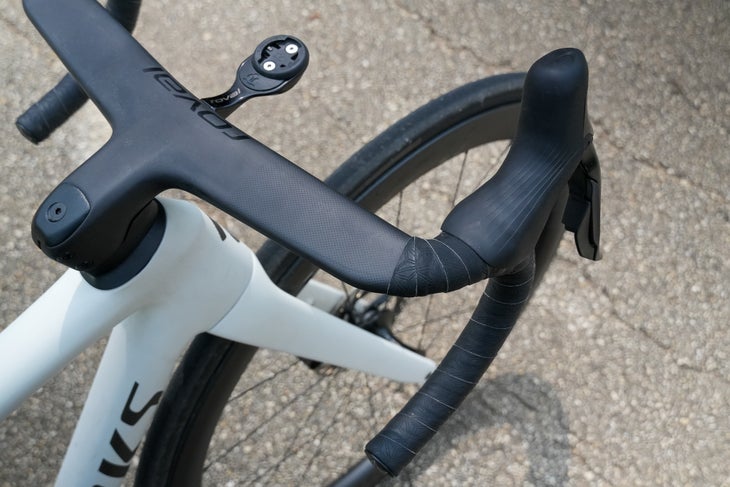
However, it is the Roval Rapide one-piece carbon handlebar that makes such a big difference. According to Specialized, it amounts to “well over half of the aero story of the SL8.” You’ll want to run this bar/stem on the Tarmac if you’re looking for the most aero gains; unfortunately, this only comes stock on the S-Works level bikes.
Outside of those five aforementioned parts of the bike, the Tarmac is largely focused on being as light as possible. The downtube, top tube, and stays are almost cylindrical in shape. Specialized says this pulls a page or two out of the ultralight Aethos playbook. It results in a seriously lightweight frame, regardless of whether you go for the standard 10r carbon frame or the S-Works carbon frame I have here.
Geometry
| Size (cm) | 44 | 49 | 52 | 54 | 56 | 58 | 61 |
| Seat tube (mm) | 435 | 447 | 458 | 475 | 496 | 517 | 547 |
| Top tube (mm) | 496 | 509 | 531 | 541 | 563 | 577 | 595 |
| Head tube (mm) | 93 | 102 | 113 | 131 | 151 | 178 | 198 |
| Head angle (deg) | 70.50° | 71.75° | 72.50° | 73.00° | 73.50° | 73.50° | 74.00° |
| Seat angle (deg) | 75.50° | 75.50° | 74.00° | 74.00° | 73.50° | 73.50° | 73.00° |
| Chainstay (mm) | 410 | 410 | 410 | 410 | 410 | 410 | 410 |
| BB Drop (mm) | 74 | 74 | 74 | 72 | 72 | 72 | 72 |
| Wheelbase (mm) | 970 | 973 | 975 | 978 | 991 | 1,006 | 1,013 |
| Reach (mm) | 369 | 378 | 383 | 387 | 398 | 405 | 411 |
| Stack (mm) | 491 | 504 | 517 | 534 | 555 | 581 | 602 |
As requested by Specialized pro riders, handling geometry is unchanged between bikes. Fit geometry is changed ever so slightly due to how the headtube interfaces with the headset cover. The result is an ever so slightly higher stack height compared to the SL7, but Specialized assured us that fit geometry will remain the same when measuring the length from seat to stem.
The previous generation Tarmacs were lively in feel and unashamedly race-centric road bikes. That continues here.
Real-world weights of a Specialized Tarmac SL8
In for review was a 2024 Specialized S-Works Tarmac SL8 Dura-Ace Di2. It came in a size 52 cm. While I did not individually weigh the Dura-Ace Di2 groupset, I did weigh nearly everything else individually. Here’s what I found:
| Component | Name | Type | Weight (actual, grams) | Weight (claimed, grams) |
| Frame | S-Works Tarmac SL8 | Pearl white, size 52 cm without hardware | 740 | 685 |
| Fork | S-Works Tarmac SL8 | Pearl white, cut to one spacer under the stem | 340 | 358 |
| Headset & hardware | Specialized Tarmac SL8 | Headset with slightly cut expander plug, seat post wedge, Di2 battery mount, thru axles, computer mount, derailleur hangers, mounts | 268 | 256 |
| Cockpit | Roval Rapide Cockpit | 40 cm width x 90 mm length | 320 | 323 |
| Seatpost | S-Works Tarmac SL8 | 15 mm setback | 165 | 161 |
| Wheelset | Roval Rapide CLX II | Shimano freehub with stock rim tape | 1490 | 1520 |
| Tires | S-Works Turbo Rapidair | 700c x 26 mm | 470 | 460 |
| Tubes | Specialized Turbo Ultralight | 60 mm/80 mm valves | 80 | 80 |
| Drivetrain | Shimano Dura-Ace R9270 | 52-36t chainrings, 11-30T cassette, 170 mm cranks w/ 4iiii dual-sided pm, 160 mm/140 mm rotors | 2478 | 2470 |
| Saddle | S-Works Power | 155 mm | 160 | 159 |
| Bar tape and plugs | Supacaz Super Sticky Kush | Black | 65 | 68 |
| Total | 6574 | 6620 |
The key takeaway here is the weight of this bike. At just 6.57 kg (14.5 pounds) in my size 52 cm, there are few bikes that simply come close to the low weight that this bike offers. Add in a set of clipless pedals and decent bottle cages and the bike is still just under that magic 6.8 kg.
Building the Specialized Tarmac SL8
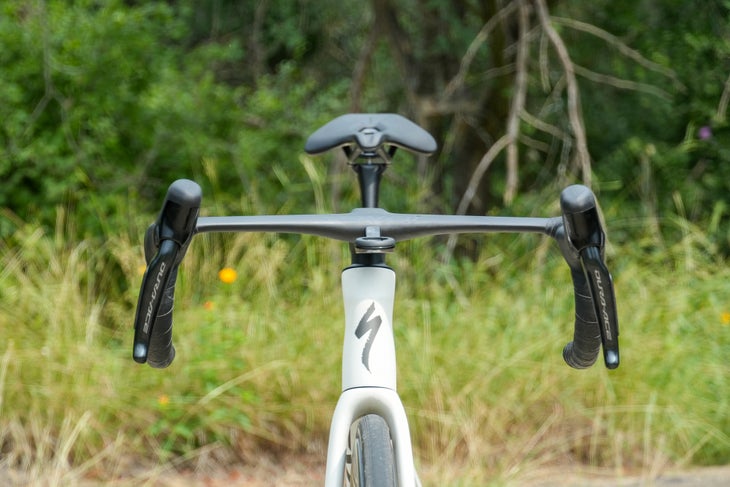
Specialized got off to a bit of a rough start with the Tarmac SL7, at least when it came to the included expander plug. The early expander plug resulted in a recall that replaced its more traditional-looking plug with a shorter expander plug attached to a much longer aluminum tube.
The plug here isn’t all that different from what was implemented in the SL7, with the same extended aluminum tube and a new compression wedge with an external sleeve around the wedge. It requires cutting the aluminum tube when the steerer tube is shorter than the plug, as I had to do to get the bars where I needed them. Its weight (45 g as measured) feels antithetical to the weight-saving mission of the Tarmac, but the peace of mind is nice to have.
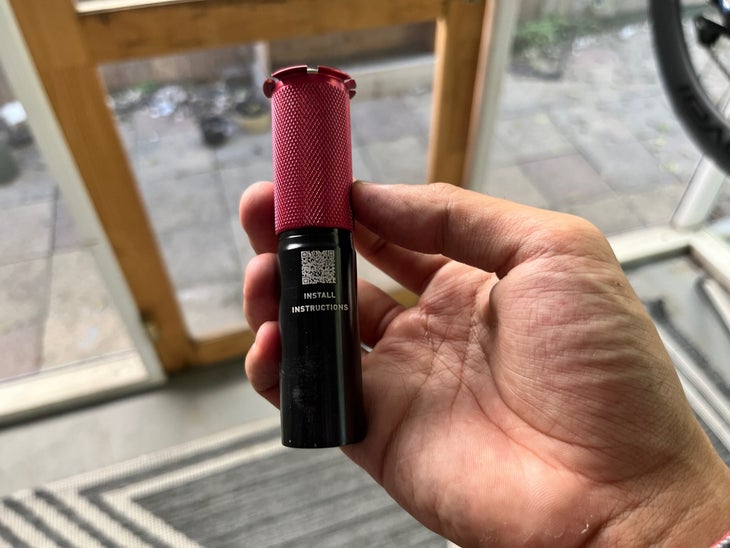
Around that expander plug and steerer tube is Specialized’s internal cable routing system. It consists of a composite compression ring, a headset cap (that Specialized calls the lower transition), interlocking spacers, and an upper transition that guides the brake hoses into the handlebars. In my eyes, it’s one of the better internal cable routing systems around. It won’t convince internal routing haters to make the switch, but the smooth transitions do a good job of preventing brake hoses from being kinked, and the hoses don’t make noise inside of the frame as you ride along.
I should note that Specialized says that folks who want to swap from the stock Roval Rapide cockpit will need to purchase a new cockpit, even if they’re buying a new bike. This is where I think the internal cable routing haters have a point; the labor to either cut the steerer tube or swap bars requires cutting at least one brake hose, and that’s before mentioning the $600 US to buy a new, matching Roval Rapide cockpit.
Maybe that’s a non-issue for the folks who buy one of these new. But for the new cyclist who likely scrimped and saved to get into a Tarmac SL8 secondhand, it’s a bummer. That’s doubly so for someone who buys this secondhand and takes it to a local bike shop to get their bars lower.
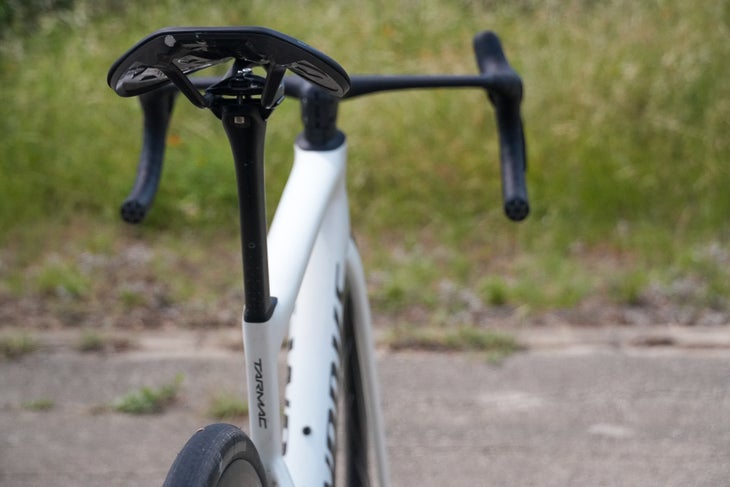
The new Tarmac SL8 seatpost is far slimmer than before, and so slim that it can’t fit a Shimano Di2 battery. Specialized’s solution is to clip the battery to the bottom of the seat post. The solution felt precarious when you first inserted the battery and seat post, but I ended up having zero issues with the mount.
The potential issue I did find with this system is that it limits the minimum seat post height; push the seat post too far down and the Di2 battery will hit the seat tube’s upper bottle cage mount. That said, adjusting the seat post is a straightforward affair, with a single two-piece seat post wedge requiring a torque of 6.2 Nm.
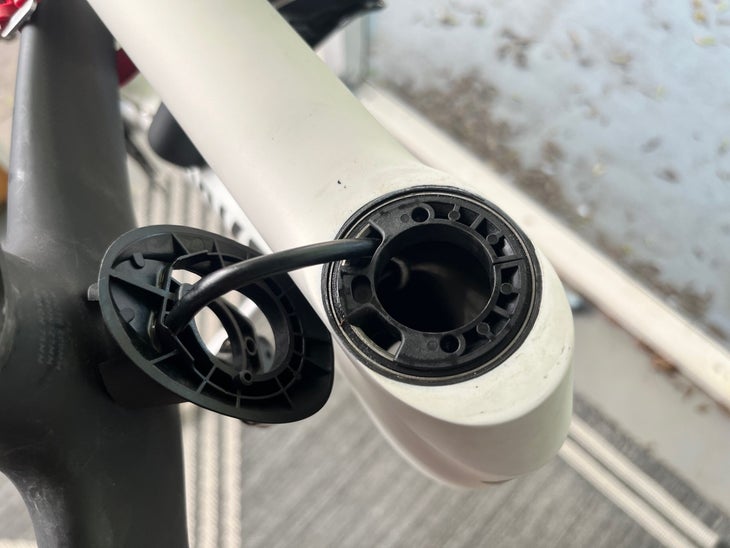
Considering this is a bike that’s so focused on going as fast as possible, the Tarmac SL8 is relatively easy to work on. The cables routed under the stem means the bike can be taken apart to be placed in a standard bike bag without issue. Everything fits together nicely, and the more traditional 1 ⅛” steerer tube and BSA threaded bottom bracket make finding replacement parts somewhat an uncomplicated affair.
While I didn’t see anything out of the ordinary from a brief inspection, I did notice that the flat mount brake caliper points were faced nicely, as was the BSA threaded bottom bracket. Neither needed to be faced as the brakes set up easily and the bottom bracket felt smooth. You expect these to largely be taken care of at this price point; good thing they were.
Here’s what I learned after riding the Specialized Tarmac SL8 after eight months
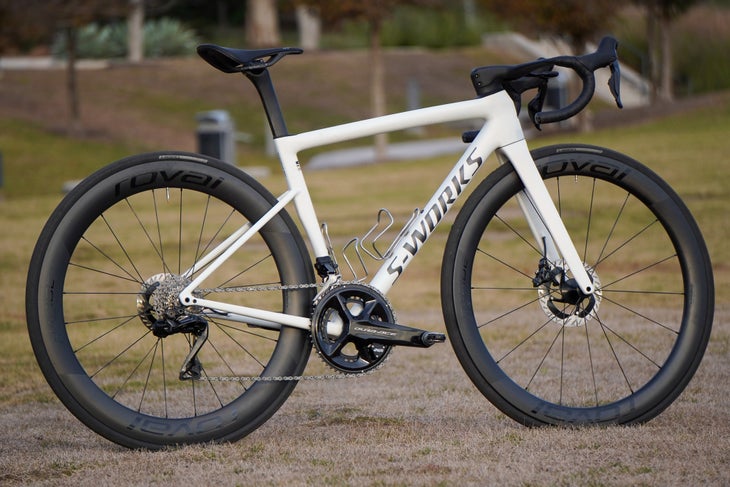
This long-term review was supposed to be a six-month affair. Because of scheduling (and frankly, liking the bike) it ended up being more of an eight-month review. The result? 2,958 kilometers ridden (1838 miles for the Imperial users out here) from October 2023 to May 2024 and outside of a few flat tires, zero issues.
My bike was the Specialized S-Works Tarmac SL8 built with Shimano Dura-Ace Di2. This 52 cm bike weighed in at 6.62 kg (14.7 pounds) without pedals or cages, as mentioned up top.
My first ride review of the Tarmac SL8 was fairly positive. It’s a fast-feeling bike right out of the box, with geometry that feels immediately familiar to anyone who has ridden a Tarmac in the last eight years or so. For those who haven’t ridden one though, the Tarmac feels energetic and exceptionally dynamic regardless of whether you’re climbing or descending.
Specialized’s weight loss regimen provides the Tarmac with a sense of verve when climbing that the previous SL7 didn’t quite match. Frankly, its climbing prowess feels quite similar to that of the Aethos. The bike feels as light as it comes. There’s hardly any feeling of needing to overcome inertia on the bike, either. You pedal and it goes forward, without delay.
Where it departs from the Aethos–and frankly, falls in line with the rest of the best race road bikes out there–is how it goes about finding that speed. In my first ride, I mentioned that the Tarmac SL8 felt surgical. That continues here. Stand up and pedal with all your might and the bike rockets forward. Lean your hips toward the apex of a corner and the bike follows. It does everything you’d want to get up to speed thanks to its excellent front-end and bottom bracket stiffness.
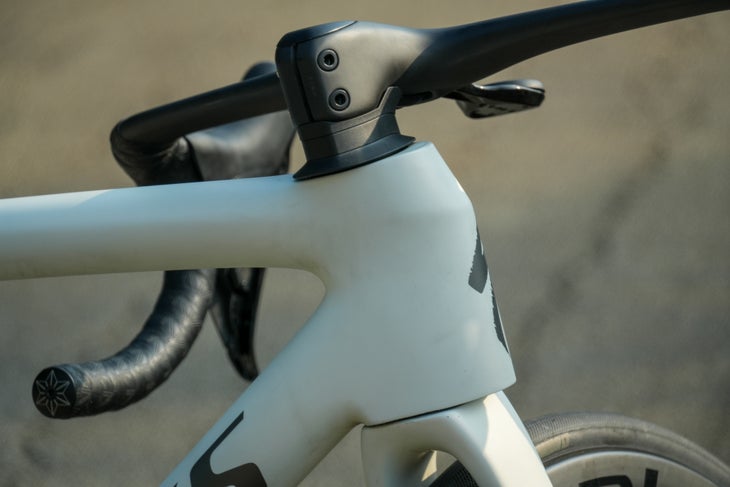
The Tarmac SL8 is just so good at finding that last ounce of speed, particularly as speeds rise. It doesn’t quite carry speed and momentum like the best aero road bikes, but it has a similar thrum at speed as the likes of the Cannondale SuperSix Evo or even the Factor Ostro Vam. That sensation is compounded by looking down at my bike computer and continually going faster than I thought I was.
Where it goes ahead of many of these bikes in how it combines its front-end stiffness while being composed on rough surfaces. There’s a sense of stoutness that comes when you’re hammering on the bike in my experience that doesn’t usually come with bikes this lightweight, which makes steering precision just that little bit better. At the same time, the bike doesn’t skip around like you’d expect a bike as light as this to do. Really, it goes about its business so competently that you’re never surprised by anything it does, both good and bad.
I don’t want to sound like I’m complaining. I’m not! The Tarmac SL8 is about as good as it gets if you’re looking for a bike to race on. It’s an even better bike for someone who wants to look or feel like they’re going racing. What it isn’t is the right bike for everyone.
I don’t think Specialized thinks this is the road bike for everyone, but its popularity forces people to think that way. Approach as a racey, performance-first bike and you’ll be more than happy.
How did the rest of the build fare?
Of course, a bike isn’t just the frame and fork: it’s everything else. For the most part, the S-Works Tarmac fits the bill of a top-spec road bike. And you’d hope for it too, as it costs $14,000 US!
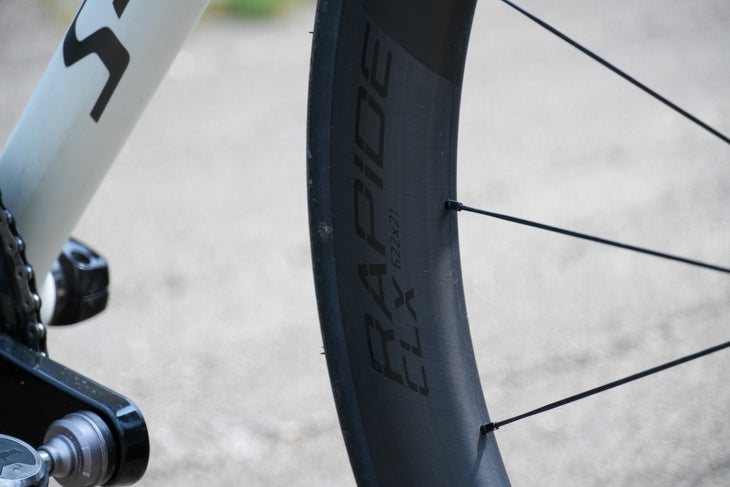
Let’s start with the Roval Rapide CLX II wheels. The carbon wheels feature a 51 mm deep rim up front and a 60 mm deep wheel out back. The hooked bead rims feature a 21 mm internal rim width for each side. Where the wheelset diverges is on the external rim width, measuring 30 mm out back and a massive 35 mm up front. This type of width calms down those moments of instability one might experience in a crosswind, important for wheels this deep.
Despite the wheelset’s imposing depth and width, the Rapide CLXII wheels (the standard version of the Rapide CLX Team wheels we reviewed) aren’t too heavy, at 1,520 grams for the set measured. There are lighter options out there that don’t seem to make aero sacrifices; the Black Inc 48|58 and the Enve SES 4.5 come to mind. However, these are still impressive wheels that spin up without hesitation, feel stiff under big cornering loads, and don’t get blown around too much. Best of all, they set up tubeless with just a floor pump! Can’t take that for granted.
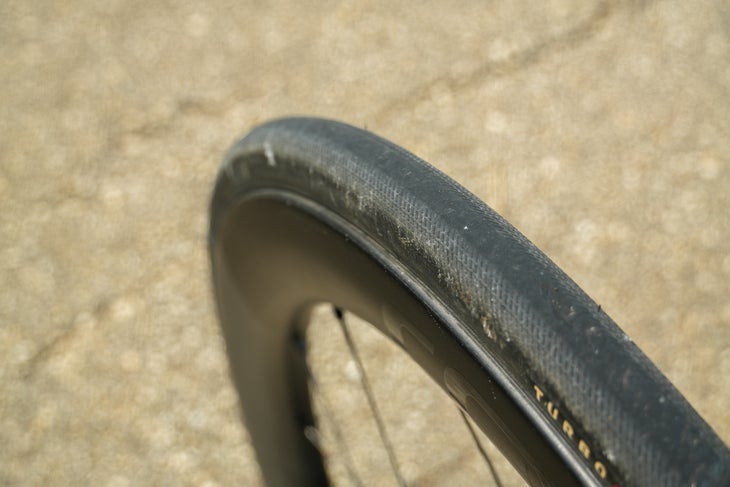
The S-Works Turbo tires that come with the bike are surely effective. They’re quick, grippy in both dry and wet conditions, and seem to fit the bill for the Tarmac’s go-fast intentions. The stock 26 mm tires–which Specialized tells me was done to market demands– are much narrower than the bikes using 28 mm and even 30 mm tires. But these measured to 27 mm at 80 PSI front and rear. They’re not the most durable tires, as they started to get regular flats after roughly 1400 miles.
Were I to hold onto this bike longer, I’d want to swap the tires out immediately. I’d go for something wider, as limited experimentation with other tires found going wider did little to change the character of the Tarmac.
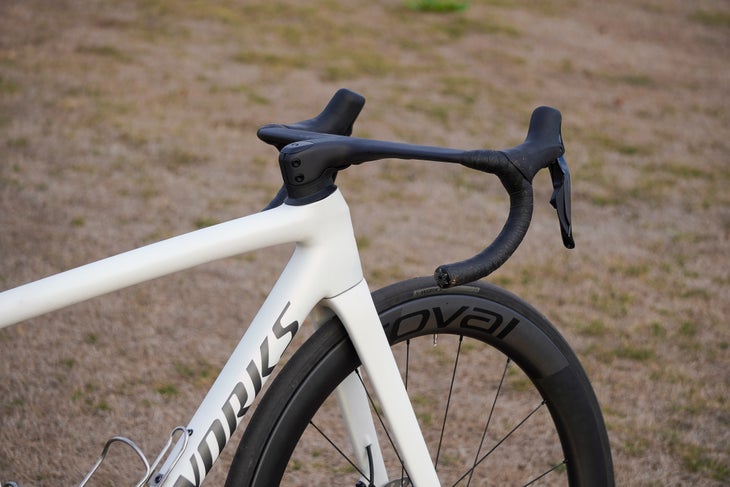
The Roval Rapide Cockpit bars were great, frankly. They feel plenty stiff yanking on them in the drops, but not so unyielding that they’re vibration magnets when you’re riding up top. The aero top is also plenty comfortable, with a hit of textured finish at the top to grip if you’re not running bar tape up top.
My only thought is that the stock bar width–40 cm on my size 52 cm bike–should be narrower. Specialized tells me that these widths come from their Retul fit database. That may be very well, but I cannot imagine many folks of my stature riding a bike like this who want 40 cm wide bars. For a bike with all the race pretenses that the Tarmac does, a narrower bar that flares in the drops would be ideal.
No complaints about the Shimano Dura-Ace Di2 drivetrain, which proved to be reliable, quiet, and efficient. Choosing between SRAM, Shimano, and Campagnolo has largely become a choice of personal preference at this point. All three weigh roughly the same at this point, with shift performance that is close enough to one another to be happy with either choice.
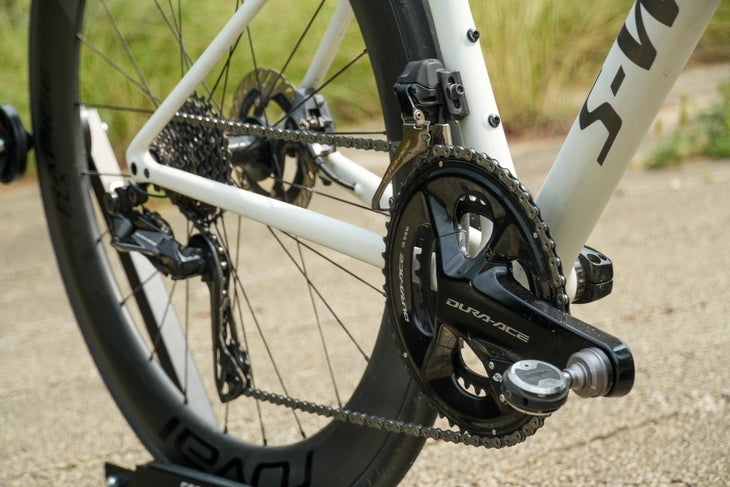
The 4iii dual-sided power meter was a bit more complicated. Power meter data seemed to read high indoors, even with calibration. But when the battery died on the right-side crank, the left-side-only version seemed to fall in line much more with both the Favero Assioma MXII and Wahoo Speedplay Pwrlnk pedals. Power readings were consistent enough for me to not want to swap it out myself, but there seem to be more precise options out there.
I should note as well that as good as this satin white finish looks on the Specialized Tarmac SL8, it’s a pain to keep clean. Dish soap, water, and a sponge aren’t enough to remove grime from riding. It’s a labor of love to have this finish, and if you need their bike to be constantly clean, you’re better served with a gloss finish.
Conclusion
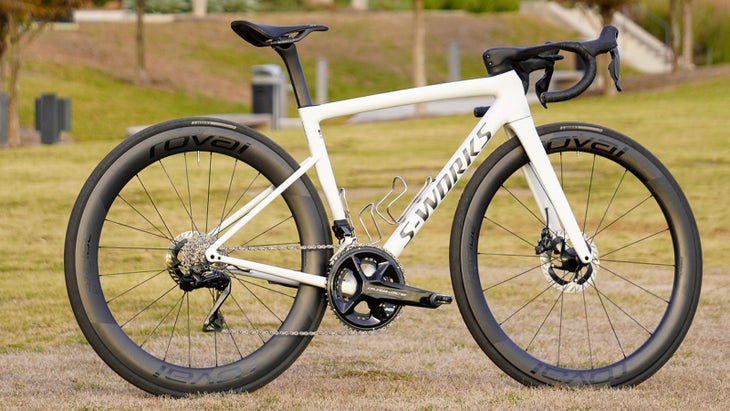
It’s almost frustrating how good the Specialized Tarmac SL8 is in everything it does. It’s one of the best climbing bikes I’ve ever ridden, one of the most confidence-inspiring bikes I’ve ridden while descending, and a bike that gives the rider zero excuse for a lack of performance. If I’m using one bike to regularly race AND ride on my own, you’d be truly splitting hairs picking another bike of this caliber.
Unfortunately for me, however, my job is to split hairs, especially when the road bikes are as good as our current crop of road bikes has become. For me? I wish the ride quality was just a touch smoother, particularly up front. I wish it wasn’t so expensive, even at the entry level. The rider should be able to choose the right bar and stem for their fit when new, but that’s especially the case when you’re spending this much money.
The Tarmac SL8 isn’t perfect, contrary to what Specailzed’s biggest fans might tell you. But as someone who has the chance to ride almost all of the latest and greatest, it’s truly a challenge to do better than this.
Gallery
